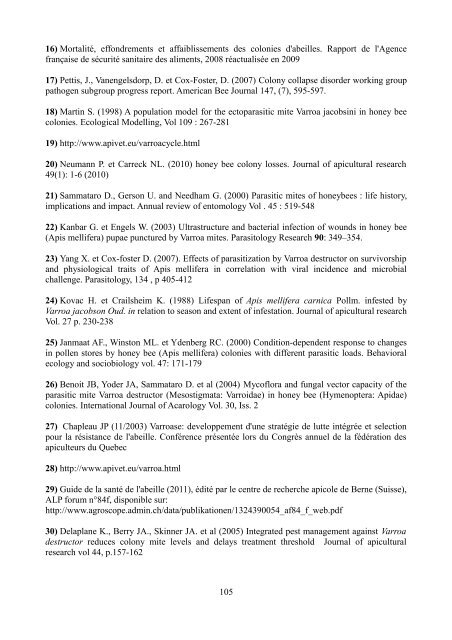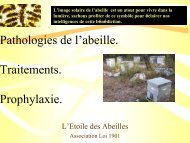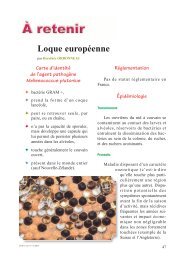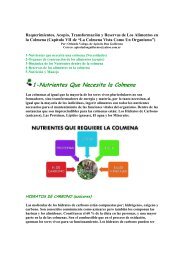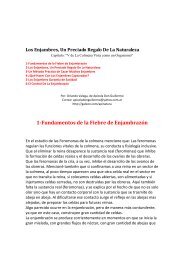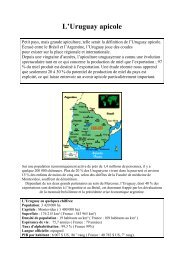La disparition des abeilles (Colony Collapsus Disorder)
La disparition des abeilles (Colony Collapsus Disorder)
La disparition des abeilles (Colony Collapsus Disorder)
Create successful ePaper yourself
Turn your PDF publications into a flip-book with our unique Google optimized e-Paper software.
16) Mortalité, effondrements et affaiblissements <strong>des</strong> colonies d'<strong>abeilles</strong>. Rapport de l'Agence<br />
française de sécurité sanitaire <strong>des</strong> aliments, 2008 réactualisée en 2009<br />
17) Pettis, J., Vanengelsdorp, D. et Cox-Foster, D. (2007) <strong>Colony</strong> collapse disorder working group<br />
pathogen subgroup progress report. American Bee Journal 147, (7), 595-597.<br />
18) Martin S. (1998) A population model for the ectoparasitic mite Varroa jacobsini in honey bee<br />
colonies. Ecological Modelling, Vol 109 : 267-281<br />
19) http://www.apivet.eu/varroacycle.html<br />
20) Neumann P. et Carreck NL. (2010) honey bee colony losses. Journal of apicultural research<br />
49(1): 1-6 (2010)<br />
21) Sammataro D., Gerson U. and Needham G. (2000) Parasitic mites of honeybees : life history,<br />
implications and impact. Annual review of entomology Vol . 45 : 519-548<br />
22) Kanbar G. et Engels W. (2003) Ultrastructure and bacterial infection of wounds in honey bee<br />
(Apis mellifera) pupae punctured by Varroa mites. Parasitology Research 90: 349–354.<br />
23) Yang X. et Cox-foster D. (2007). Effects of parasitization by Varroa <strong>des</strong>tructor on survivorship<br />
and physiological traits of Apis mellifera in correlation with viral incidence and microbial<br />
challenge. Parasitology, 134 , p 405-412<br />
24) Kovac H. et Crailsheim K. (1988) Lifespan of Apis mellifera carnica Pollm. infested by<br />
Varroa jacobson Oud. in relation to season and extent of infestation. Journal of apicultural research<br />
Vol. 27 p. 230-238<br />
25) Janmaat AF., Winston ML. et Ydenberg RC. (2000) Condition-dependent response to changes<br />
in pollen stores by honey bee (Apis mellifera) colonies with different parasitic loads. Behavioral<br />
ecology and sociobiology vol. 47: 171-179<br />
26) Benoit JB, Yoder JA, Sammataro D. et al (2004) Mycoflora and fungal vector capacity of the<br />
parasitic mite Varroa <strong>des</strong>tructor (Mesostigmata: Varroidae) in honey bee (Hymenoptera: Apidae)<br />
colonies. International Journal of Acarology Vol. 30, Iss. 2<br />
27) Chapleau JP (11/2003) Varroase: developpement d'une stratégie de lutte intégrée et selection<br />
pour la résistance de l'abeille. Conférence présentée lors du Congrès annuel de la fédération <strong>des</strong><br />
apiculteurs du Quebec<br />
28) http://www.apivet.eu/varroa.html<br />
29) Guide de la santé de l'abeille (2011), édité par le centre de recherche apicole de Berne (Suisse),<br />
ALP forum n°84f, disponible sur:<br />
http://www.agroscope.admin.ch/data/publikationen/1324390054_af84_f_web.pdf<br />
30) Delaplane K., Berry JA., Skinner JA. et al (2005) Integrated pest management against Varroa<br />
<strong>des</strong>tructor reduces colony mite levels and delays treatment threshold Journal of apicultural<br />
research vol 44, p.157-162<br />
105


